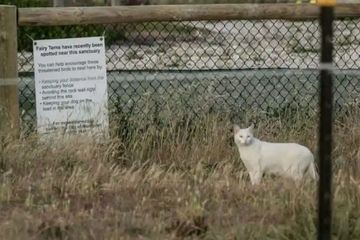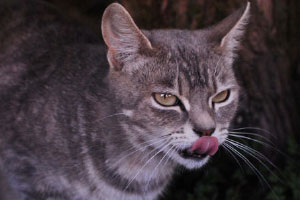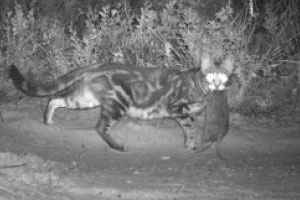
This cat was caught on camera with native Lewin’s rails in its mouth on two separate occasions near Clump Lagoon on French Island National Park in Victoria. The images were captured by the Feral Cat Free French Island Project.
Feral cats have been catastrophic for Australian wildlife. They threaten the survival of more than 100 of our native species and, along with the fox, have been the main driver of wildlife extinctions in our country since European arrival. Cats also pose a threat to livestock as carriers of the parasites toxoplasma and sarcosporidiosis.
Now, the Victorian government has an opportunity to make huge inroads into the impacts of feral cats, but it can only do so if changes are made to the regulations governing the use of traps in that state.
The government will put in place a new Prevention of Cruelty to Animals Regulations by 15 December 2019. The regulations are aimed at protecting animals by minimising harm through the regulation of specific activities, yet perversely could have the opposite effect by disallowing the use of a critical tool in the control and local eradication of feral cats, which by their nature cause huge pain, suffering and population declines for our native species.
Unless the new regulations are amended soft leg hold traps for the capture of feral cats will not be allowed, despite being currently allowed for the capture of wild dogs, foxes and rabbits.
However, we are urging the Victorian Government to allow the careful, considerate use of soft leg hold traps to support the control and eradication of feral cats under the new Prevention of Cruelty to Animals Regulations.
Such use will give land managers the tools they need to protect native wildlife from the devastating impacts of feral cats and bring Victoria into line with most other states and territories. It would also honour the environment minister’s feral cat commitment to remove unnecessary barriers to effective and humane control of feral cats.
Soft leg hold traps would also enable Parks Victoria to achieve its goal of eradicating feral cats from French Island National Park. This would be an incredible achievement and place the island next to other feral cat free islands including Gabo Island in Victoria, Tasman, Macquarie and Wedge islands in Tasmania and Dirk Hartog and Faure islands in Western Australia.
The new regulations should be released before the end of the year.
Animal welfare for our native species
Stopping agencies such as Parks Victoria from using soft leg hold traps as part of their work in controlling and eradicating feral cats has huge implications for the welfare and even survival of many native Victorian species.
A case in point is the work being undertaken on French Island National Park, where Parks Victoria has been running an intensive feral cat cage trapping program since 2012. More than 100 cages are put out every night over a 16 week period of each year. Skilled catchers have used the cages to trap and remove about 1100 cats from the island, and the local Landcare group has worked closely with those living on the island so that now all but one of the island’s domestic cats have been sterilised.
This is an extraordinary achievement, but because current Victorian regulations disallow the use of soft leg hold traps the program cannot achieve its goal of total feral cat eradication from this important wildlife island sanctuary.
The cages have been effective in trapping and removing parts of the French Island feral cat population, but cage traps alone are not sufficient for completing the job because the larger, adult feral cats that are the biggest killers of our wildlife tend to be wary of cage traps and will not enter them. Sufficient numbers of breeding age cats remain after each trapping program to perpetuate the feral cat population.
Feral cats are highly evolved hunters that have a behavioural preference for live prey, which reduces the appeal of cage traps to successful adult individuals. If these feral cats cannot be targeted and controlled through the use of soft leg hold traps they will remain in the landscape, breed and pass on their avoidance behaviours to future generations of cats.
In a detailed study of trapping methods by CSIRO and Murdoch University, researchers found that cage traps and soft leg hold traps captured cats at comparable rates but leg hold traps caught considerably more adult feral cats.
To safeguard native wildlife Victoria needs to allow the considerate use of soft leg hold traps to control feral cats under its new Prevention of Cruelty to Animals Regulations.
Soft leg hold traps will give land managers the tools they need to protect native wildlife from the devastating impacts of feral cats. If cats can be eradicated entirely from an isolated area, it will end the cycle of trapping and killing of feral cats.
It will also enable Parks Victoria to complete its goal of eradicating feral cats from French Island National Park. This would be an incredible achievement and place the wildlife sanctuary next to other feral cat free islands including Gabo Island in Victoria, Tasman, Macquarie and Wedge islands in Tasmania and Dirk Hartog and Faure islands in Western Australia.
The Invasive Species Council is committed to minimising animal suffering in feral animal control. In considering the animal welfare outcomes of any proposed control measure, the broader context of animal welfare must be taken into account.
The Invasive Species Council is a member of the national feral cat taskforce, convened by the Threatened Species Commissioner.




